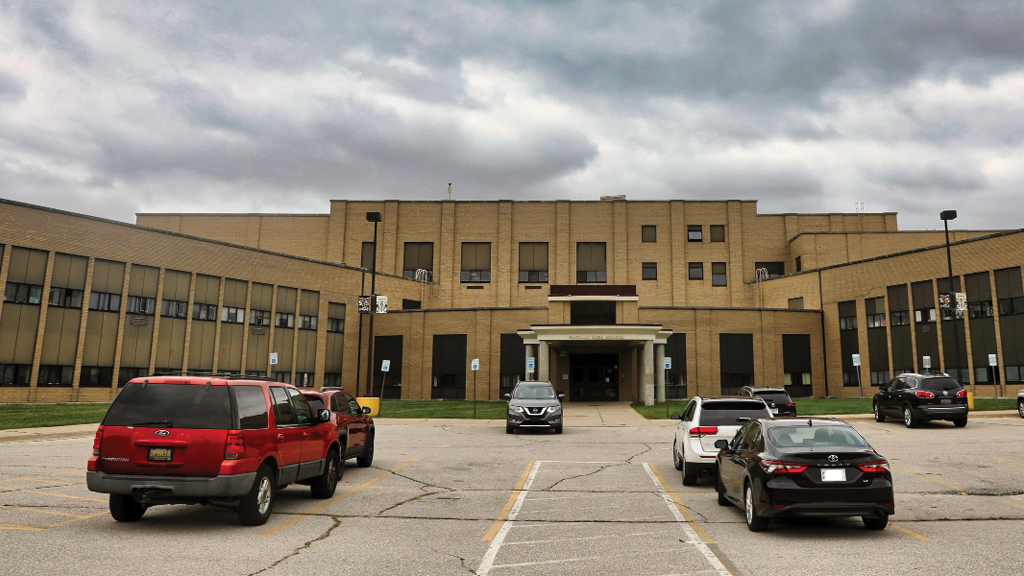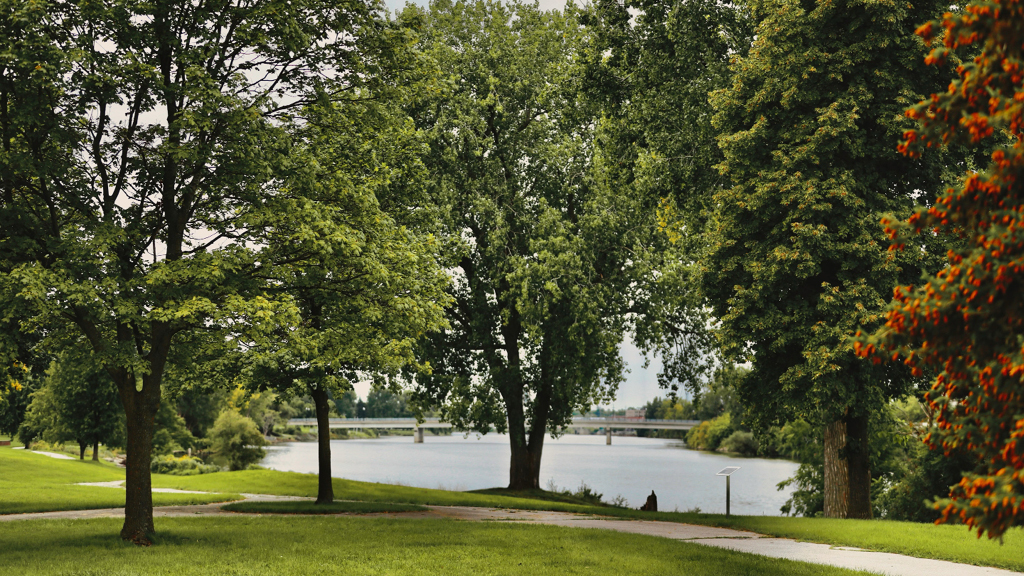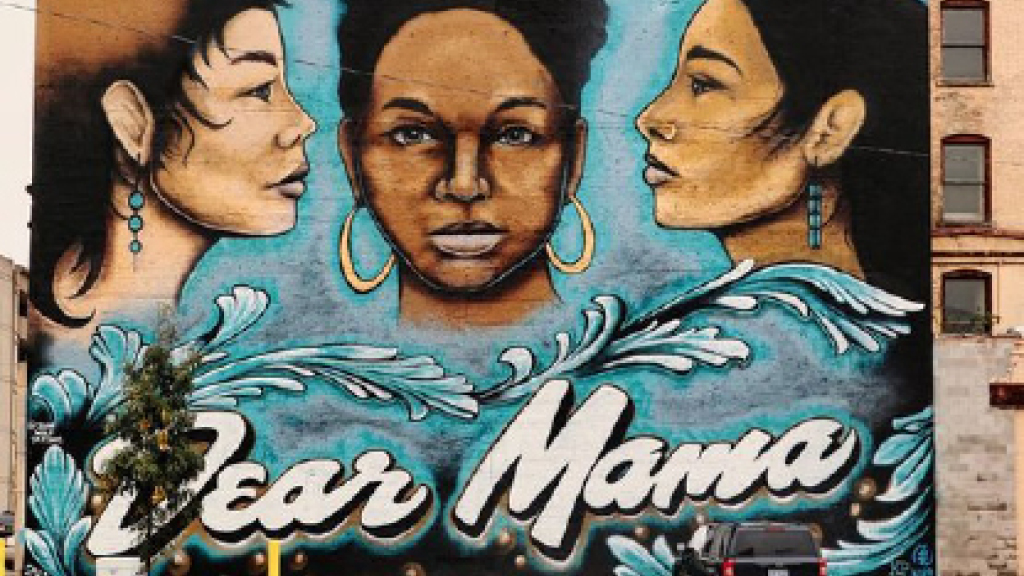
TOP TO BOTTOM: SAGINAW HIGH SCHOOL PRINCIPAL ERIC GORDON, SAGINAW HIGH SCHOOL SENIOR LADONNA JONES, AND SAGINAW PUBLIC SCHOOLS SUPERINTENDENT RAMONT ROBERTS AT THE CONSTRUCTION SITE OF THE NEW SAGINAW UNITED HIGH SCHOOL.
Eric Gordon is walking from the library of his mostly empty high school when he sees two teens in an embrace. “Knock it off,” the principal says as the teens separate. “Go back to class.” Moments later, he checks to see whether a third student has a hall pass and exhorts another to “take that hood off” as the youth strolls down the hallway.
“I treat these kids like they’re my own,” says Gordon, principal of Michigan’s Saginaw High School. “I treat them like I’m their parent. When kids know you love them, you can move mountains with them.”
Gordon’s approach — the Saginaw native calls education his “life’s mission” — is a mantra for educators in this once prosperous industrial hub that ranks fourth on the list of America’s most violent cities. According to a 2021 FBI crime statistics report, one in 38 Saginaw residents has a chance of being a victim of a violent crime, a number higher than Detroit — 90 minutes to the south — and other large urban communities.
Community violence is a societal concern with no easy fix, but district leaders point to signs of hope after three decades of dramatic decline in a town divided racially and economically by a river, an interstate, and a struggling industry that largely abandoned it. Enrollment, which plunged from 25,000 students to 5,100 over three decades, has finally stabilized and grown by more than 300 post-COVID. A $99.5 million bond referendum passed in 2020 will merge the district’s two traditional high schools — Saginaw and Arthur Hill — into the new Saginaw United High School starting next year.
“We face challenges every single day,” Superintendent Ramont Roberts says, “but we are on the right track.”
Roberts and other school leaders in Saginaw believe they also have the right programs and people in place to deal with the trickle-down effects of community violence, which can result in far-reaching and devastating psychological challenges for students and dramatically impede their ability to be academically successful.
“If a student is not emotionally sound, not socially sound, not psychologically sound, then they’re not ready to learn,” Roberts says. “We have to check those boxes first before we begin with learning.”

SAGINAW HIGH SCHOOL, BUILT FOR 1,600 STUDENTS, NOW HOUSES ONLY 421 IN ITS FINAL YEAR. THANKS TO A BOND REFERENDUM PASSED, THE CAMPUS WILL BE RENOVATED AND USED AS A MIDDLE SCHOOL ONCE THE NEW SAGINAW UNITED HIGH SCHOOL IS COMPLETE.
Community challenges
The summer of 2023 was particularly violent in Saginaw, a city of 43,000, less than half of its peak in 1960. In late June, the city exceeded its 2022 total for nonfatal shootings when two people were killed and 13 wounded during an unauthorized street party. Two weeks later, a 15-year-old shooting victim was found dead in the basement of an abandoned house on the city’s east side.
Then, in late July, an 18-year-old Saginaw student athlete was shot and killed in a yard in the nearby Buena Vista Township. The youth, an Arthur Hill senior, had just attended the first day of football practice.
“After the first day of practice, that team had to go to the funeral of a classmate,” says Charles Coleman, the school board chair. “Had it been an auto accident, you could deal with that. If it had been natural causes you could deal with that. But the fact he was found shot in a yard? Who can make sense of that?”
Community violence is linked to increased risk of developing chronic diseases, and people with multiple adverse childhood experiences are more likely to have short-term and chronic physical and mental health conditions, according to the Centers for Disease Control and Prevention. In 2020, more than half of U.S. homicides in 2020 occurred among people ages 15 to 34, with homicide rates higher among non-whites.
Coleman, Roberts, and other district officials refuse to weigh-in on the city’s response to violent crime, instead praising their relationship with the police department and pointing to the work the schools are doing to protect and educate students. In each instance this summer, the school district made grief counselors available through its partnership with the Saginaw County Community Mental Health Authority. The authority and school district contract with a third-party provider to provide social workers at elementary campuses. Therapists also are sent to the middle and high schools when students are referred for services.
Jennifer Keilitz, the authority’s director of network services, says the number of phone calls from residents seeking mental health assistance for youth has doubled this year.
“Gun violence, domestic violence, and overall anxiety are the biggest things,” Keilitz says. “The kids just have a lot more anxiety right now. A lot is coming at them all the time. They don’t know how to unplug.”
Leann Bauer, Saginaw’s executive director of special education and student support services, says 4.5% more students now receive special education services since the pandemic. Since this school year started, the district has received 60 additional parent requests for evaluations.
Bauer’s department oversees two health clinics — one at each traditional high school — as well as nine social workers, counselors for grades 7-12, three nurses, one mental health practitioner, and health resource advocates who work with students on social and emotional health. With student and family needs continuing to increase, she wishes the district could afford more social workers.
“It’s a challenge,” she says. “Our kids are challenging.”

THE SAGINAW RIVER THAT DIVIDES THE COMMUNITY.
Dividing lines
In some respects, Saginaw’s struggles are no different than what other communities experience when a large employer downsizes or relocates. But few have experienced such a dramatic economic and population decline in such a relatively short period of time.
Over the past two decades, Saginaw has closed more than a dozen elementary schools and one middle school due to losses in enrollment, which started in the early 1990s and accelerated over the past two decades before stabilizing in 2021.
Forty years ago, Saginaw and the neighboring Buena Vista Township were home to a dozen General Motors (GM) plants. At its peak, GM had more than 30,000 people working in Saginaw alone, with an additional 30,000 in the Saginaw-Midland-Bay City complex. Today, only one GM plant remains in the city; in 2009, the year GM filed for bankruptcy, unemployment in Saginaw reached 23.5%.
“When I was growing up, we had great recreational programming, great parks, and amazing activities for kids,” says Roberts, who graduated from a since closed high school in Buena Vista in 1993. “You had a thriving school system during the day, and a thriving recreational system in the after-school hours, on weekends, during breaks, and more important, during the summertime.
“If a person who had not been here for 30 years came back to Saginaw now,” he says in a moment of candor, “their heart would be broken. It doesn’t look that way anymore.”
Coleman, who also is a former city councilman, has seen it all in his hometown — the ups and downs, the prosperity and poverty, the gaps perpetuated by battles over class and race. He graduated from Saginaw High in 1970, three years after the Detroit riots, and remembers the drawbridges that once connected the white and Black communities being left up at night.
“When I was growing up, the Saginaw River was the actual dividing line,” says Coleman, a second-generation pastor who spent most of his career organizing nonprofit groups. “They told my generation, ‘Leave Saginaw.’ Our class had almost 700 kids and the majority of my classmates did not come back. We were graduating from Saginaw High School with honors, and they were telling us not to come back.”
Coleman points to the early 1970s construction of Interstate 675, which further bisects west and east Saginaw, as another community dividing point. To the west, the city became a suburb, complete with restaurants, a shopping mall, and other amenities. Meanwhile, the eastern side has become riddled with blight. More than 1,000 homes — many of them multiple story dwellings built in the 1920s and 1930s, have been identified for demolition.
“When they put in 675, they called it urban renewal, an attempt to revitalize sectors of a community,” Coleman says. “What 675 did for Saginaw was carve out one part of the city that was predominantly minority and isolate it from everything. It gave people a path through the city without having to stop so they could go to the suburbs.”
‘Take that burden off you’
As Gordon walks back to his office, he passes the entrance to an empty wing of the school that has been taped off. Thanks to the referendum, Saginaw High and Arthur Hill are being renovated this year, the former into a second middle school and the latter into a campus for the Saginaw Arts & Sciences Academy, a grades 9-12 magnet that is one of highest rated high schools in the state.
“These buildings are so big,” says Gordon, who has 421 students on a campus built to hold 1,600. “The best thing we can do is build a new building and consolidate the high schools there. We need to give our community a fresh start.”
Gordon says the violence in Saginaw has affected his school— “How could it not?” — but notes the district has done “everything we can” to help students. The list is long: behavioral and academic interventions, with a focus on peer mediation and restorative justice; truancy abatement clerks, a licensed nurse practitioner in the building, and student access to a mental health therapist.
“Everything starts with relationships and with relationship building,” Gordon says. “Our kids see a lot and they go through a lot, but this is the one steady place where they know they can get a meal, where they can get the attention they need.”
Often, he says, students just need to talk to a supportive adult about their issues. When working with children who are dealing with trauma, he says conversations “have to go two ways.”
“We know there are things they can’t talk about at home or in the community, but they can talk to us,” Gordon says. “The best approach with these kids is to be a listener. Our kids go through enough trauma before they ever enter this building. People just barking at them, ‘You did this. You did that.’ I tell them to come into my office and ‘take that burden off you.’”
One student Gordon has gotten to know well is senior LaDonna Jones, who has become one of Saginaw High’s success stories. Jones has run track and field, is part of the student council, and helped plan the school’s final homecoming. A dual enrollment student at Delta College, she will have 32 college credits when she graduates and hopes to major in education.
Jones praises the “great support system” she has at the school and lauds the small class sizes that give her “close contact” with teachers and staff. But when asked about the violence that has plagued her community, especially this past summer, she is polite but guarded.
“These are my peers. They don’t have to be my close friends, but I’ve seen them at basketball games and football games,” Jones says. “We’re the same age, and they’re not going to age anymore. They’re gone because they’re getting into the wrong things.”
She looks down at the table and continues. “It just shows me, sadly enough, what not to do. It’s a lesson through other people. It’s just not the greatest story.”

A MURAL IN THE PARKING LOT OF DELTA COLLEGE, WHICH NOW HAS A DOWNTOWN CAMPUS USED BY DUAL ENROLLMENT STUDENTS. THE MURAL HONORS THE STRENGTH, RESILIENCE, AND DIVERSITY OF MOTHERS IN SAGINAW.
Recovery
Against the odds, the district’s slow but steady rebound is becoming a good story, one that starts with a superintendent and school board working together.
After high school, Roberts left Michigan for a decade, first to Louisiana’s Xavier University where he played basketball, then to Harvard’s Graduate School of Education. He returned in 2003 as a building-level administrator and worked as an assistant principal and principal at two schools while earning his doctorate.
“Saginaw was home,” he says when asked why he moved back. “My wife and I had two young children and both of our families still lived here. It was the right move at the time.”
By this point, Saginaw’s enrollment was in freefall, forcing the district to close schools to make ends meet. Between 2003 and 2009, nine small elementary campuses were shuttered, and two middle schools consolidated.
In 2012, Michigan cut its per-pupil allocation by $437 per student, forcing the closure of two more schools that year, followed by two in 2013 and three in 2014, including the consolidated middle school. That closure forced the district to move its sixth graders back to the elementary campuses and operate a single grades 7-8 campus.
“It was a series of compounding factors hitting you year after year,” says Roberts, noting Buena Vista closed its schools for good during this time due to financial insolvency. “School districts across this state were not prepared for that $437 per-pupil hit. We had to make drastic cuts to programming and staffing to get our budget under control, and that took years.”
Roberts spent three years as an assistant superintendent, then took over as superintendent in 2018, the same year Coleman was elected to the board. By this point, enrollment had bottomed out, and the district was financially stable. In 2019, after attending a Michigan Association of School Boards (MASB) training session on strategic planning, Roberts and the board agreed to undertake the effort in Saginaw, with an eye toward a bond referendum.
“We brought in a consultant from MASB who walked us through this process, asking us what we wanted our school district to look like in five years,” Coleman says. “We knew our two comprehensive high schools were built in the 1950s and were designed to hold 1,500 students apiece, but they barely had 1,000 students together. But we also knew, based on experience and failure, that this was something that could not be board driven. It had to be community driven.”
Roberts formed a committee of community members who met over several months and agreed to support a referendum to build a new high school. Students at the two high schools already are combined for most sports and other extracurricular activities, and surveys showed they supported the move.
In November 2020, at one of the heights of the pandemic, all but one of the city’s voting precincts supported the referendum. Today, the new high school — Saginaw United, a name picked by students — is under construction in the center of the city, on a piece of land next to the river.
Glenn Cook (glenncook117@gmail.com), a contributing editor to American School Board Journal, is a freelance writer and photographer in Northern Virginia.

Share this content